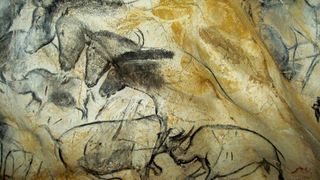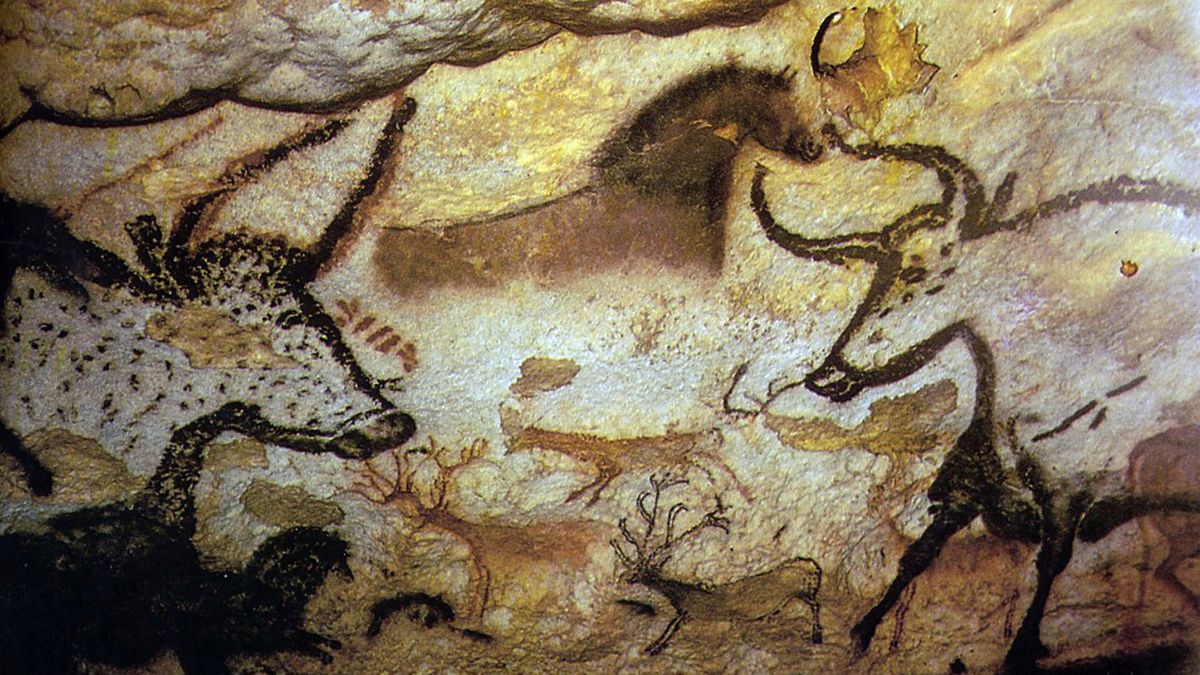Caves are natural shelters. Throughout our history, humans have made extensive use of them as spaces to create art, inter the dead and butcher animals for food and clothing. In this countdown, Live Science takes a look at seven incredible caves that people used over the ages, leaving behind evidence of their crafts, dead and leftovers. Some of the caves were used by our now-extinct relatives, including the Neanderthals, Denisovans and Homo erectus.
Lascaux cave
Lascaux cave in southwestern France contains about 680 painted frescoes and 1,500 engravings that were created around 21,000 years ago, according to the French Ministry of Culture. Much of the artwork shows animals, including depictions of horses, bison, deer, bears and aurochs (Bos primigenius) — a species of now-extinct bovine. The artwork also features geometric elements, including dots, lines and pentagonal shapes. One of the paintings may show a human figure with a bird-like head, possibly someone wearing a mask. At the time the art was created, people were living as hunters and gatherers, and it’s possible that rituals of some form took place in the cave.
Chauvet cave

Chauvet cave in southeastern France has drawings and engravings that date to around 32,000 years ago, according to the Metropolitan Museum of Art in New York City. The cave’s interior includes images of horses, bears, lions, rhinoceroses, deer, panthers, bison, owls and mammoths. The remains of human handprints have also been found inside Chauvet. Many of the drawings were created using either red or black ochres. There is one enigmatic image that shows the lower half of a woman’s body alongside what appears to be a bison.
Zhoukoudian caves
Located near Beijing, China, the Zhoukoudian caves contain remains of our ancestor H. erectus — sometimes called “Peking man.” Many of the fossils were lost during World War II, but excavations have been carried out at the site in recent times with a team carrying out a re-excavation of the cave in 2012. Scientists have found the remains of stone tools that were used for scraping and softening animal hides. These hides were probably used as clothing. It’s still debated when Peking man used the caves, but it may have been at different times between roughly 200,000 and 800,000 years ago. Homo sapiens also made use of the caves around 18,000 to 11,000 B.C., UNESCO reports. Remains of their burials have been found within the caves.
Cave of Swimmers
The “Cave of Swimmers” is located in southwestern Egypt in an area that is now arid and has relatively little plant and animal life. The cave gets its name from rock art that depicts people who appear to be swimming. Other art in the cave shows people who appear to be running, walking or engaged in other activities. There are also images of human handprints and an engraved antelope’s hoofprint, according to the British Museum. The artwork’s age is a matter of debate, but it may have been created between 6,000 and 9,000 years ago — a time when the environment in the region was much wetter.
Denisova cave
Denisova cave is located in Siberia, Russia. A hermit named Denis lived there in the 1700s, which is how it became known as the “cave of Denis” in Russian. The cave’s archaeological remains indicate that at least three hominins — H. sapiens, Neanderthals and Denisovans — likely occupied the site at different points in time. Stone tools found in deep layers indicate the cave’s earliest residents lived there around 300,000 years ago, the University of Oxford reported.
Other finds include hominin bones and teeth, as well as the bone of a 13-year-old girl who was a Denisovan-Neanderthal hybrid. Archaeologists have also unearthed pendants made of animal teeth that date back between roughly 43,000 and 49,000 years ago that were likely made by H. sapiens. The remains of stone tools that were likely used for butchering animals have also been discovered.
Atapuerca caves
The caves of the Sierra de Atapuerca in Spain were used by people from nearly 1 million years ago to modern times, according to UNESCO. Neanderthals and Homo sapiens both used the caves, and Homo antecessor, Homo heidelbergensis and H. erectus may also have used them. The remains of tools and animal bones indicate that people were butchering bison in the caves about 400,000 years ago. Rock art, both painted and engraved, has been discovered in the caves and includes depictions of animals, people and geometric motifs.
Cave of Altamira
The cave of Altamira in Spain was used by humans roughly 36,000 to 13,000 years ago, according to the Bradshaw Foundation. The cave is about 885 feet (270 meters) long and contains a vast amount of rock art. (A replica of the rock art is seen above). Perhaps the most remarkable example is a ceiling with colorful paintings depicting 25 bison that are up to 5.6 feet (1.7 m) in length, alongside two horses and a deer. To create this ceiling artwork, prehistoric artists engraved and outlined the figures and then colored them in with paint made from ochre, the foundation notes.


